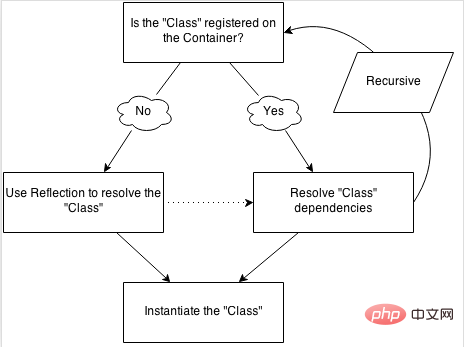What is laravel dependency injection
The term laravel dependency injection is a term proposed by Martin Fowler. It is a behavior of injecting components into an application. Dependency injection is a key element in agile architecture. Examples of use are such as "class UserProvider{protected $connection...}".

The operating environment of this article: Windows 7 system, Laravel version 5.7, DELL G3 computer.
What is laravel dependency injection?
Detailed explanation of dependency injection and IoC in Laravel:
As developers, we Always trying to find new ways to write well-designed and robust code by using design patterns and trying new robust frameworks. In this article, we'll explore the Dependency Injection design pattern with Laravel's IoC components and see how it can improve our designs.
Dependency Injection
The term dependency injection is a term proposed by Martin Fowler. It is the act of injecting components into an application. As Ward Cunningham said:
Dependency injection is a key element in agile architecture.
Let's look at an example:
class UserProvider{
protected $connection;
public function __construct(){
$this->connection = new Connection;
}
public function retrieveByCredentials( array $credentials ){
$user = $this->connection
->where( 'email', $credentials['email'])
->where( 'password', $credentials['password'])
->first();
return $user;
}
}If you want to test or maintain this class, you must access the database instance to perform some queries. To avoid having to do this, you can decouple this class from other classes, you have one of three options to inject the Connection class without using it directly.
When injecting components into a class, you can use one of the following three options:
Constructor method injection
class UserProvider{
protected $connection;
public function __construct( Connection $con ){
$this->connection = $con;
}
...Setter method injection
Similarly, we also Dependencies can be injected using the Setter method:
class UserProvider{
protected $connection;
public function __construct(){
...
}
public function setConnection( Connection $con ){
$this->connection = $con;
}
...Interface injection
interface ConnectionInjector{
public function injectConnection( Connection $con );
}
class UserProvider implements ConnectionInjector{
protected $connection;
public function __construct(){
...
}
public function injectConnection( Connection $con ){
$this->connection = $con;
}
}When a class implements our interface, we define the injectConnection method to resolve dependencies.
Advantages
Now when testing our classes we can mock dependent classes and pass them as parameters. Each class must focus on a specific task and should not be concerned with resolving their dependencies. This way, you'll have a more focused and maintainable application.
If you want to learn more about DI, Alejandro Gervassio has covered it extensively and expertly in this series of articles, so be sure to read them. So, what is IoC? IoC (Inversion of Control) does not require the use of dependency injection, but it can help you manage dependencies effectively.
Inversion of Control
Ioc is a simple component that makes it easier to resolve dependencies. You can describe the object as a container, and every time a class is resolved, dependencies are automatically injected.
Laravel Ioc
Laravel Ioc is a little special in the way it resolves dependencies when you request an object:

We use A simple example will improve it in this article. The SimpleAuth class depends on FileSessionStorage, so our code might look like this:
class FileSessionStorage{
public function __construct(){
session_start();
}
public function get( $key ){
return $_SESSION[$key];
}
public function set( $key, $value ){
$_SESSION[$key] = $value;
}
}
class SimpleAuth{
protected $session;
public function __construct(){
$this->session = new FileSessionStorage;
}
}
//创建一个 SimpleAuth
$auth = new SimpleAuth();This is a classic approach, let's start with using the constructor Function injection begins.
class SimpleAuth{
protected $session;
public function __construct( FileSessionStorage $session ){
$this->session = $session;
}
}Now we create an object:
$auth = new SimpleAuth( new FileSessionStorage() );
Now I want to use Laravel Ioc to manage all this.
Because the Application class inherits from the Container class, you can access the container through the App facade.
App::bind( 'FileSessionStorage', function(){
return new FileSessionStorage;
});bind The first parameter of the method is the unique ID to be bound to the container, and the second parameter is a callback function that is executed whenever the FileSessionStorage class is executed. , we can also pass a string representing the class name as shown below.
Note: If you look at the Laravel package, you will see that bindings are sometimes grouped, such as ( view, view.finder ...).
Assuming we convert the session store to Mysql storage, our class should look like:
class MysqlSessionStorage{
public function __construct(){
//...
}
public function get($key){
// do something
}
public function set( $key, $value ){
// do something
}
} Now that we have changed the dependencies, we also need to change the SimpleAuth construct function and bind the new object to the container!
High-level modules should not depend on low-level modules, both should depend on abstract objects.
Abstraction should not depend on details, details should depend on abstraction.Robert C. Martin
Our SimpleAuth class should not care about how our storage is done, instead it should focus more on consuming the service.
Therefore, we can abstractly implement our storage:
interface SessionStorage{
public function get( $key );
public function set( $key, $value );
} so that we can implement and request an instance of the SessionStorage interface:
class FileSessionStorage implements SessionStorage{
public function __construct(){
//...
}
public function get( $key ){
//...
}
public function set( $key, $value ){
//...
}
}
class MysqlSessionStorage implements SessionStorage{
public function __construct(){
//...
}
public function get( $key ){
//...
}
public function set( $key, $value ){
//...
}
}
class SimpleAuth{
protected $session;
public function __construct( SessionStorage $session ){
$this->session = $session;
}
}如果我们使用 App::make('SimpleAuth') 通过容器解析 SimpleAuth
类,容器将会抛出 BindingResolutionException ,尝试从绑定解析类之后,返回到反射方法并解析所有依赖项。
Uncaught exception 'Illuminate\Container\BindingResolutionException' with message 'Target [SessionStorage] is not instantiable.'
容器正试图将接口实例化。我们可以为该接口做一个具体的绑定。
App:bind( 'SessionStorage', 'MysqlSessionStorage' );
现在每次我们尝试从容器解析该接口时,我们会得到一个 MysqlSessionStorage 实例。如果我们想要切换我们的存储服务,我们只要变更一下这个绑定。
Note: 如果你想要查看一个类是否已经在容器中被绑定,你可以使用 App::bound('ClassName') ,或者可以使用 App::bindIf('ClassName') 来注册一个还未被注册过的绑定。
Laravel Ioc 也提供 App::singleton('ClassName', 'resolver') 来处理单例的绑定。
你也可以使用 App::instance('ClassName', 'instance') 来创建单例的绑定。
如果容器不能解析依赖项就会抛出 ReflectionException ,但是我们可以使用 App::resolvingAny(Closure) 方法以回调函数的形式来解析任何指定的类型。
Note: 如果你为某个类型已经注册了一个解析方式 resolvingAny 方法仍然会被调用,但它会直接返回 bind 方法的返回值。
小贴士
这些绑定写在哪儿:
如果只是一个小型应用你可以写在一个全局的起始文件global/start.php中,但如果项目变得越来越庞大就有必要使用 Service Provider 。测试:
当需要快速简易的测试可以考虑使用php artisan tinker,它十分强大,且能帮你提升你的 Laravel 测试流程。Reflection API:
PHP 的 Reflection API 是非常强大的,如果你想要深入 Laravel Ioc 你需要熟悉 Reflection API ,可以先看下这个 教程 来获得更多的信息。
相关推荐:最新的五个Laravel视频教程
The above is the detailed content of What is laravel dependency injection. For more information, please follow other related articles on the PHP Chinese website!

Hot AI Tools

Undresser.AI Undress
AI-powered app for creating realistic nude photos

AI Clothes Remover
Online AI tool for removing clothes from photos.

Undress AI Tool
Undress images for free

Clothoff.io
AI clothes remover

Video Face Swap
Swap faces in any video effortlessly with our completely free AI face swap tool!

Hot Article

Hot Tools

Notepad++7.3.1
Easy-to-use and free code editor

SublimeText3 Chinese version
Chinese version, very easy to use

Zend Studio 13.0.1
Powerful PHP integrated development environment

Dreamweaver CS6
Visual web development tools

SublimeText3 Mac version
God-level code editing software (SublimeText3)

Hot Topics
 How to implement the custom table function of clicking to add data in dcat admin?
Apr 01, 2025 am 07:09 AM
How to implement the custom table function of clicking to add data in dcat admin?
Apr 01, 2025 am 07:09 AM
How to implement the table function of custom click to add data in dcatadmin (laravel-admin) When using dcat...
 How to get the return code when email sending fails in Laravel?
Apr 01, 2025 pm 02:45 PM
How to get the return code when email sending fails in Laravel?
Apr 01, 2025 pm 02:45 PM
Method for obtaining the return code when Laravel email sending fails. When using Laravel to develop applications, you often encounter situations where you need to send verification codes. And in reality...
 Laravel Redis connection sharing: Why does the select method affect other connections?
Apr 01, 2025 am 07:45 AM
Laravel Redis connection sharing: Why does the select method affect other connections?
Apr 01, 2025 am 07:45 AM
The impact of sharing of Redis connections in Laravel framework and select methods When using Laravel framework and Redis, developers may encounter a problem: through configuration...
 Laravel multi-tenant extension stancl/tenancy: How to customize the host address of a tenant database connection?
Apr 01, 2025 am 09:09 AM
Laravel multi-tenant extension stancl/tenancy: How to customize the host address of a tenant database connection?
Apr 01, 2025 am 09:09 AM
Custom tenant database connection in Laravel multi-tenant extension package stancl/tenancy When building multi-tenant applications using Laravel multi-tenant extension package stancl/tenancy,...
 Explain the concept of Dependency Injection (DI) in PHP.
Apr 05, 2025 am 12:07 AM
Explain the concept of Dependency Injection (DI) in PHP.
Apr 05, 2025 am 12:07 AM
The core value of using dependency injection (DI) in PHP lies in the implementation of a loosely coupled system architecture. DI reduces direct dependencies between classes by providing dependencies externally, improving code testability and flexibility. When using DI, you can inject dependencies through constructors, set-point methods, or interfaces, and manage object lifecycles and dependencies in combination with IoC containers.
 Laravel Eloquent ORM in Bangla partial model search)
Apr 08, 2025 pm 02:06 PM
Laravel Eloquent ORM in Bangla partial model search)
Apr 08, 2025 pm 02:06 PM
LaravelEloquent Model Retrieval: Easily obtaining database data EloquentORM provides a concise and easy-to-understand way to operate the database. This article will introduce various Eloquent model search techniques in detail to help you obtain data from the database efficiently. 1. Get all records. Use the all() method to get all records in the database table: useApp\Models\Post;$posts=Post::all(); This will return a collection. You can access data using foreach loop or other collection methods: foreach($postsas$post){echo$post->
 How to effectively check the validity of Redis connections in Laravel6 project?
Apr 01, 2025 pm 02:00 PM
How to effectively check the validity of Redis connections in Laravel6 project?
Apr 01, 2025 pm 02:00 PM
How to check the validity of Redis connections in Laravel6 projects is a common problem, especially when projects rely on Redis for business processing. The following is...
 Laravel Introduction Example
Apr 18, 2025 pm 12:45 PM
Laravel Introduction Example
Apr 18, 2025 pm 12:45 PM
Laravel is a PHP framework for easy building of web applications. It provides a range of powerful features including: Installation: Install the Laravel CLI globally with Composer and create applications in the project directory. Routing: Define the relationship between the URL and the handler in routes/web.php. View: Create a view in resources/views to render the application's interface. Database Integration: Provides out-of-the-box integration with databases such as MySQL and uses migration to create and modify tables. Model and Controller: The model represents the database entity and the controller processes HTTP requests.






